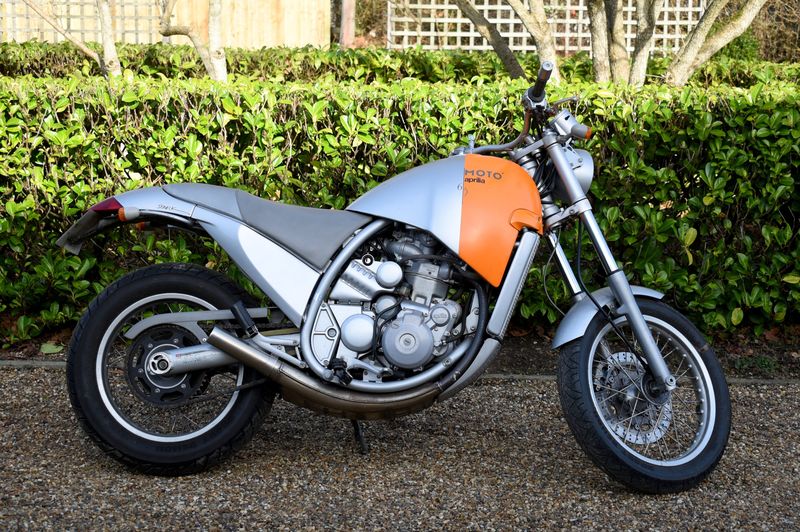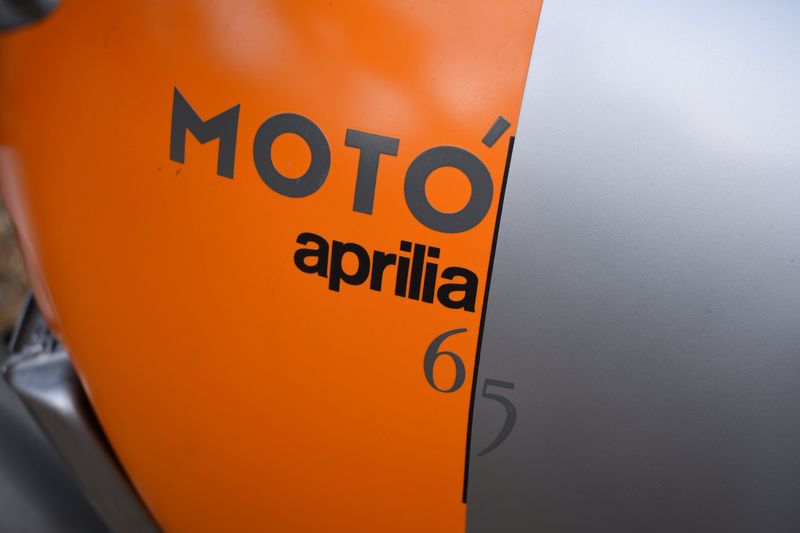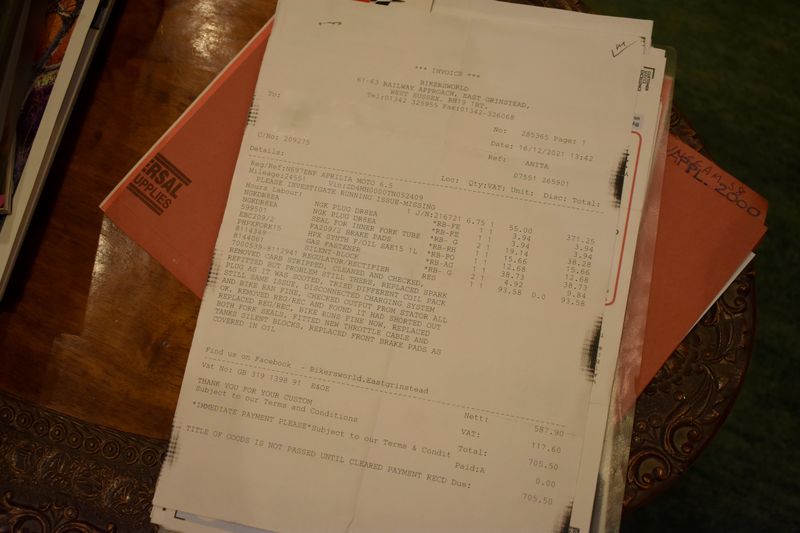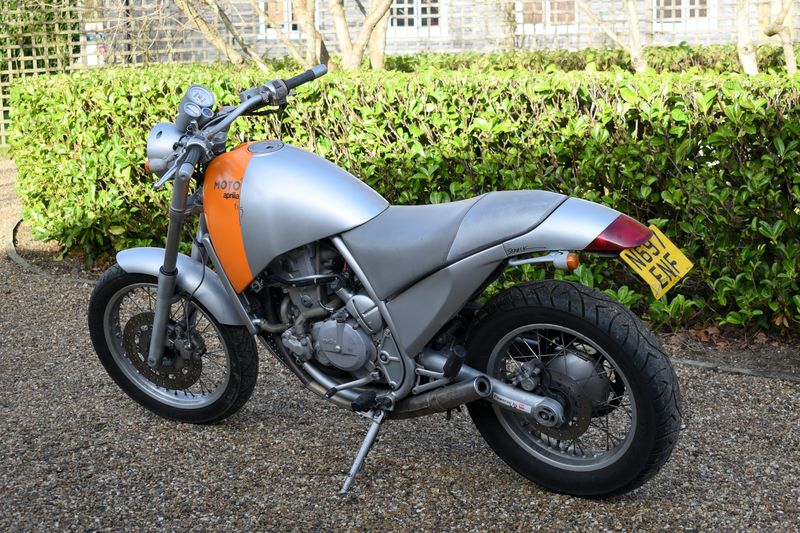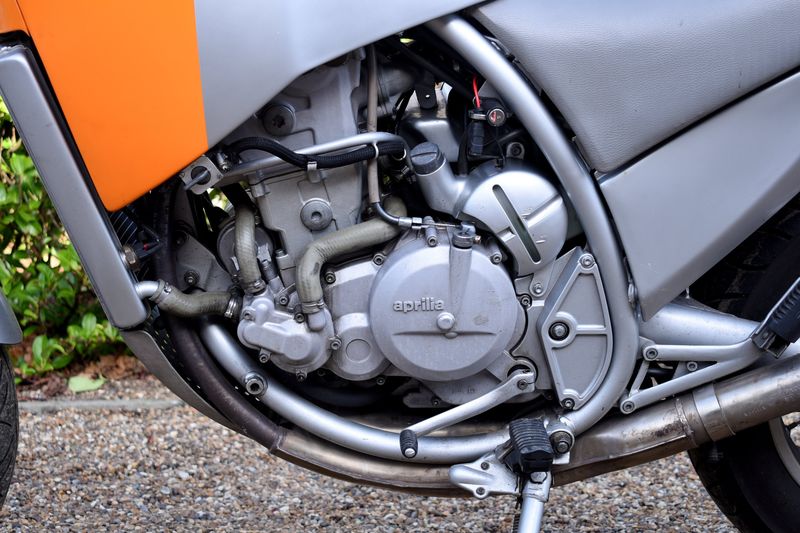Highlights
- Imported from the Netherlands in 2013
- Only two British owners
- Low mileage example
- Extensive works completed in December 2021
The Background
Starting out in bicycle production in 1945, when Aprilia branched into building mopeds from 1968 and motocross bikes from 1970, it might have aspired to emulate the commercial success of well-known Italian manufacturers such as Moto Guzzi, Ducati and MV Agusta. It might have done, but it didn’t, at least not for a while, preferring to go its own way and be a little bit experimental.
As a motorcycle maker, its focus for many years remained on motorsport, but in the 1990s it branched out into scooters and then, out of the blue, in 1995 it introduced a full-size road bike which was as much a piece of industrial sculpture as it was a motorcycle.
That bike was the Motó 6.5, and the name flashed across its rear mudguard was that of its French designer, Philippe Starck. The son of an aeronautical engineer, Starck studied at the École Camondo school of product design and worked for Adidas before setting up his own industrial design company, Starck Product. By the 1980s, he had established himself as one of the world’s leading designers and industrial architects, with clients including former French President François Mitterand. Besides architecture, he has also turned his hand to furniture, yachts and technology, but the Motó 6.5 was his only motorcycle.
There was nothing untoward about the 650cc engine from Austrian company Rotax, from whom Aprilia had occasionally bought in engines since 1985, which was also used in the BMW F650. What set the Motó apart was Starck’s avant-garde styling, the engine housed in a swirling tubular frame, crowned by a tank finished in two abruptly divided colours, with the seat and rear mudguard rising up and falling away again with the sinuous grace of a dolphin’s tail. A range of colours were offered, but the striking orange-and-silver is the best remembered. With the radiator mounted in a snug recess between the tank and an under-frame apron, it had a kind of neatness and functional elegance rarely seen in motorcycle design.
More French quirkiness than Italian raciness, the design was unmistakably the work of an æsthete and it was embraced as such, being displayed in the Museum of Modern Art in New York. Unfortunately, the more conservatively-minded market didn’t see it in quite the same way and, while sales of traditional bikes remained strong, the daring Motó 6.5 was dropped in 1997, and subsequent Aprilias have been safely conventional. If they’re rare on the Continent, they’re even rarer over here; as of 2015, it was reported that only five remained on British roads.
The History
Prior to coming to Britain, the Aprilia resided in the Netherlands were it was owned by Mr. Eric Kaim of De Bilt, near Utrecht. In 2013, Mr. Kaim sold it to Mr. Peter Rickett of Englefield Green, Surrey, who proceeded to import it into Britain.
In 2017, Mr. Rickett sold it to the vendor, a longstanding motorcycle enthusiast and collector. Since joining his stable, the Aprilia has seen light use. As an Italian bike, it is something of an anomaly in the collection, which contains some of the finest names in British motorcycling from the 1920s to the present.
As a true enthusiast with the fullest appreciation of the motorcycles he owns, the owner enjoys riding all his machines. To that end, he does not keep them over-polished or trailer them around to shows, preferring instead to use them, with all that that entails. The vendor has taken sufficient care of his machines to ensure that they run like clockwork, start willingly and run smoothly and reliably. It is in that spirit that the Aprilia has been maintained, and while it may not be concours, you’ll struggle to find an example in better mechanical fettle.
The vendor retains an attachment to all his bikes, but the decision to start a new life in Sweden means the collection has to be sold.
The Paperwork
The earliest document in the Aprilia’s file is the bill of sale from Mr. Kaim to Mr. Rickett. There follow a number of documents pertaining to the import and registration of the bike with the D.V.L.A. A second bill of sale confirms the change of ownership from Mr. Rickett to the vendor, in whose name the V5 appears.
There is a large collection of M.o.T. certificates, the most recent dating from 2018. A couple of invoices also feature, including one from Aprilia specialist Bikersworld in December 2021 detailing extensive work with a carburettor overhaul and new front brake pads. Further paperwork includes a collection of technical information issued by Aprilia in 2013 and specific to frame number ZD4MH000TN052409 and a booklet about the Motó 6.5 written in German.
The Condition
At 26 years old, the Aprilia wears its age very well. A light patina is beginning to appear across the whole bike but it remains highly presentable. The striking contrast between the silver and the orange paints still looks contemporary and, unlike certain styling cues which were fashionable in the ’90s, it has proven itself enduringly attractive. It is the case that most of the bike’s parts have acquired a few marks in places, such as may be seen on the front and rear mudguards, the indicators and on some of the exposed metal, but the paintwork generally is still in very nice condition.
One does not usually inspect the underside of a motorcycle, but since the Motó 6.5 has some panels shielding the underside in the engine, they require examination. Happily, apart from a smattering of dirt from the road, they don’t appear to have been affected by anything the wheels might have thrown up.
The wire wheels are in good condition for their age. The seat is, too, although there is some visible wear on the surface. The only faults which look to be more than superficial are some slight damage to the end of the left-hand handlebar and the cracked number plate.
The Mechanics
The vendor, as we know, maintains his bikes to use, and the Aprilia is no exception. It has been kept in good mechanical condition, so that it starts easily and runs very satisfyingly. We can’t imagine it has ever required extensive work, but it was presented to Bikersworld, an authorised Aprilia service centre in East Grinstead, in December 2021 to cure a problem with the engine missing.
After stripping, checking and cleaning the carburettor and fitting new spark plugs, Bikersworld fitted a new regulator/rectifier which resolved the trouble. It also replaced both fork seals and the front brake pads, and fitted a new throttle cable.
Since the Aprilia does not have a current M.o.T., we are unable to make any guarantees about its roadworthiness, but with regular maintenance and new brake pads fitted, it seems unlikely that there should be any cause for concern.
The Appeal
Chances are, if you’re after a conventional motorbike, the Aprilia might not appeal. But then again, if you can appreciate a bit of outside-the-box thinking and artistic design, the Motó 6.5 should be just the bike for you. Coming from a time when loud colours and lurid graphics were the height of fashion, its restrained, considered and minimalist æsthetic comes as a breath of fresh air, and the design really hasn’t dated.
The fact that it didn’t catch on at the time is perhaps an indictment of the buying public’s unwillingness to go against the grain, but it makes the Motó even more appealing to the enthusiast today on account of its rarity. With only a small handful currently on British roads, you can enjoy owning something that’s different, but which doesn’t cry out for attention – a machine for the thinking motorcyclist.
Notice to bidders
Notice to bidders
Although every care is taken to ensure this listing is as factual and transparent as possible, all details within the listing are subject to the information provided to us by the seller. Car & Classic does not take responsibility for any information missing from the listing. Please ensure you are satisfied with the vehicle description and all information provided before placing a bid.
As is normal for most auctions, this vehicle is sold as seen, and therefore the Sale of Goods Act 1979 does not apply. All bids are legally binding once placed. Any winning bidder who withdraws from a sale, is subject to our bidders fee charge. Please see our FAQs and T&C's for further information. Viewings of vehicles are encouraged, but entirely at the seller's discretion.




































































































































































































